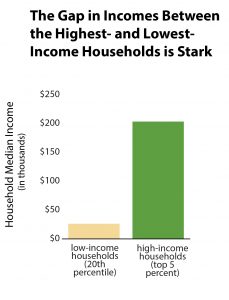Income inequality has gotten worse in Minnesota – and every state – over the past 50 years, and the highest-income households today hold a much higher share of total income, according to Census data. Even in the last decade, the share of income that has gone to the top 5 percent of households in Minnesota has risen. In 2006, their incomes were about seven times as high as the incomes of the 20 percent with the lowest incomes. By 2015, their incomes had grown to almost eight times that of low-income households.
Growing income inequality contradicts some of the country’s most deeply held values. Americans believe that hard work should pay off, that people who work full-time should be able to support their families, and that everyone should have the opportunity to succeed no matter their background. Income inequality can also be bad for the economy. When low- and middle-income households have a smaller share of the economic prosperity they help produce, it can dampen consumer spending, and slow down an important driver of economic growth.

Low-income households struggle to make ends meet and cover the costs of living. And while the cost of living is often lower in parts of Greater Minnesota, it can actually be even harder to make ends meet there. For example, in Hennepin County, low-income workers’ household incomes are $4,900 below the regional cost of living for one person, but low-income households in Mahnomen County earn nearly $10,000 less than what it costs for basic necessities.
Minnesota has some work to do so that all Minnesotans can get ahead in today’s economy. This includes improving wage and job quality standards, improving access to affordable health care and child care, and making sure workers can find housing and have transit and transportation options to get to where the jobs are. The ways we do that need to take into account the specific barriers facing Minnesota workers in each part of the state, but there’s no doubt that we need all workers to thrive for our state to thrive.
By Nathan Williams